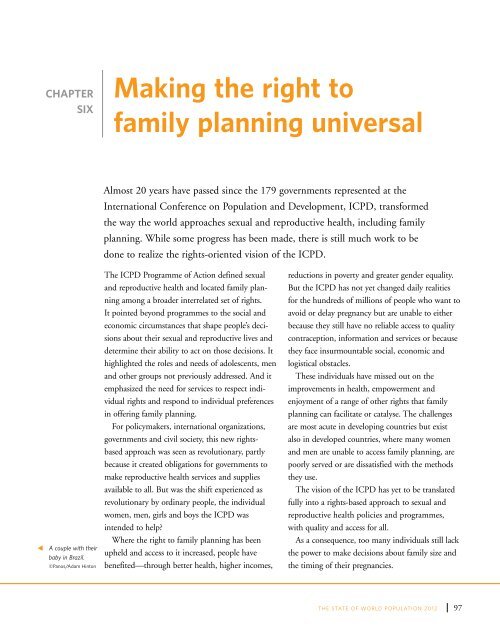State of World Population 2012 - Country Page List - UNFPA
State of World Population 2012 - Country Page List - UNFPA
State of World Population 2012 - Country Page List - UNFPA
You also want an ePaper? Increase the reach of your titles
YUMPU automatically turns print PDFs into web optimized ePapers that Google loves.
CHAPTER<br />
SIX<br />
Making the right to<br />
family planning universal<br />
Almost 20 years have passed since the 179 governments represented at the<br />
International Conference on <strong>Population</strong> and Development, ICPD, transformed<br />
the way the world approaches sexual and reproductive health, including family<br />
planning. While some progress has been made, there is still much work to be<br />
done to realize the rights-oriented vision <strong>of</strong> the ICPD.<br />
t<br />
A couple with their<br />
baby in Brazil.<br />
©Panos/Adam Hinton<br />
The ICPD Programme <strong>of</strong> Action defined sexual<br />
and reproductive health and located family planning<br />
among a broader interrelated set <strong>of</strong> rights.<br />
It pointed beyond programmes to the social and<br />
economic circumstances that shape people’s decisions<br />
about their sexual and reproductive lives and<br />
determine their ability to act on those decisions. It<br />
highlighted the roles and needs <strong>of</strong> adolescents, men<br />
and other groups not previously addressed. And it<br />
emphasized the need for services to respect individual<br />
rights and respond to individual preferences<br />
in <strong>of</strong>fering family planning.<br />
For policymakers, international organizations,<br />
governments and civil society, this new rightsbased<br />
approach was seen as revolutionary, partly<br />
because it created obligations for governments to<br />
make reproductive health services and supplies<br />
available to all. But was the shift experienced as<br />
revolutionary by ordinary people, the individual<br />
women, men, girls and boys the ICPD was<br />
intended to help<br />
Where the right to family planning has been<br />
upheld and access to it increased, people have<br />
benefited—through better health, higher incomes,<br />
reductions in poverty and greater gender equality.<br />
But the ICPD has not yet changed daily realities<br />
for the hundreds <strong>of</strong> millions <strong>of</strong> people who want to<br />
avoid or delay pregnancy but are unable to either<br />
because they still have no reliable access to quality<br />
contraception, information and services or because<br />
they face insurmountable social, economic and<br />
logistical obstacles.<br />
These individuals have missed out on the<br />
improvements in health, empowerment and<br />
enjoyment <strong>of</strong> a range <strong>of</strong> other rights that family<br />
planning can facilitate or catalyse. The challenges<br />
are most acute in developing countries but exist<br />
also in developed countries, where many women<br />
and men are unable to access family planning, are<br />
poorly served or are dissatisfied with the methods<br />
they use.<br />
The vision <strong>of</strong> the ICPD has yet to be translated<br />
fully into a rights-based approach to sexual and<br />
reproductive health policies and programmes,<br />
with quality and access for all.<br />
As a consequence, too many individuals still lack<br />
the power to make decisions about family size and<br />
the timing <strong>of</strong> their pregnancies.<br />
THE STATE OF WORLD POPULATION <strong>2012</strong><br />
97
















